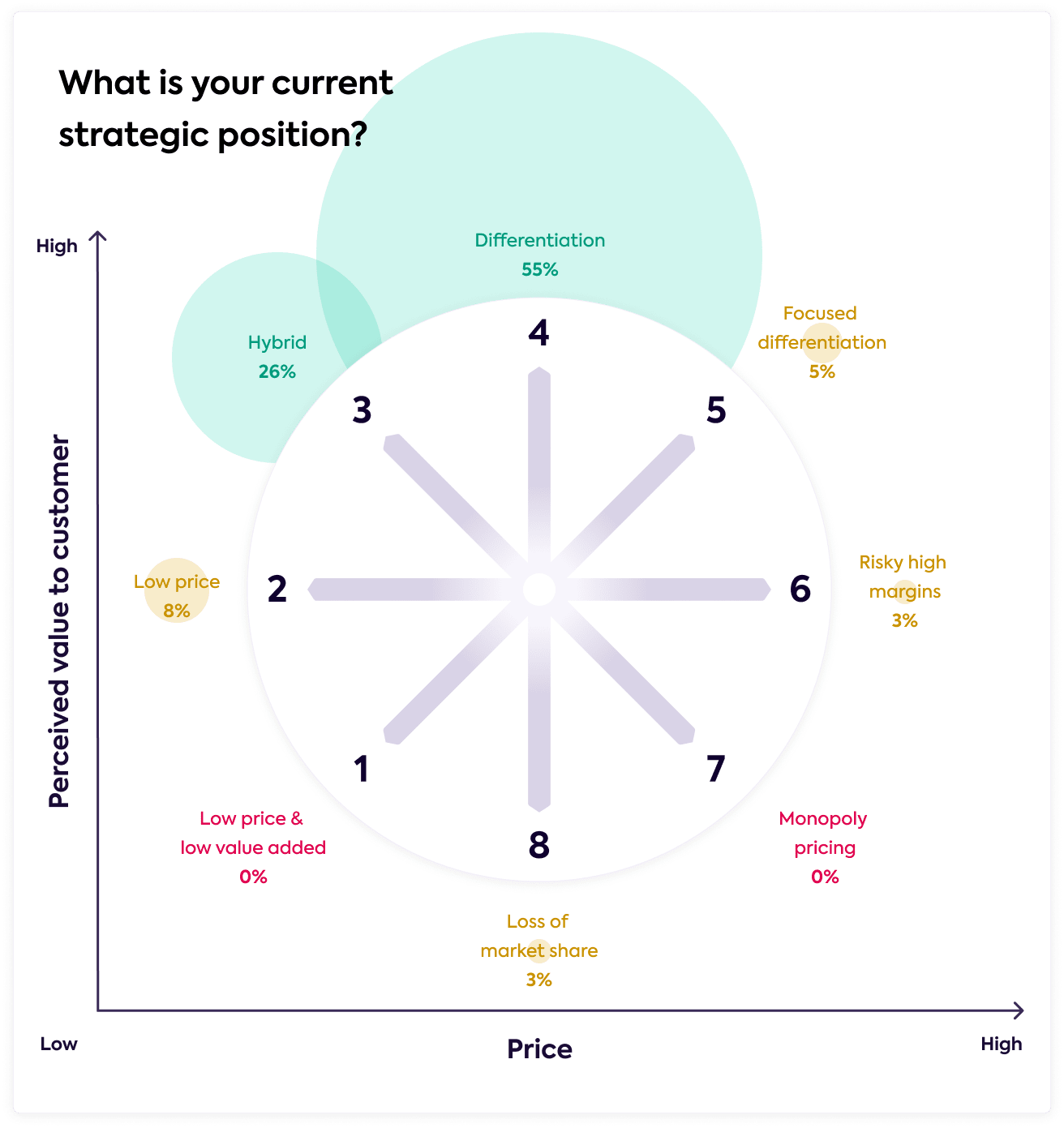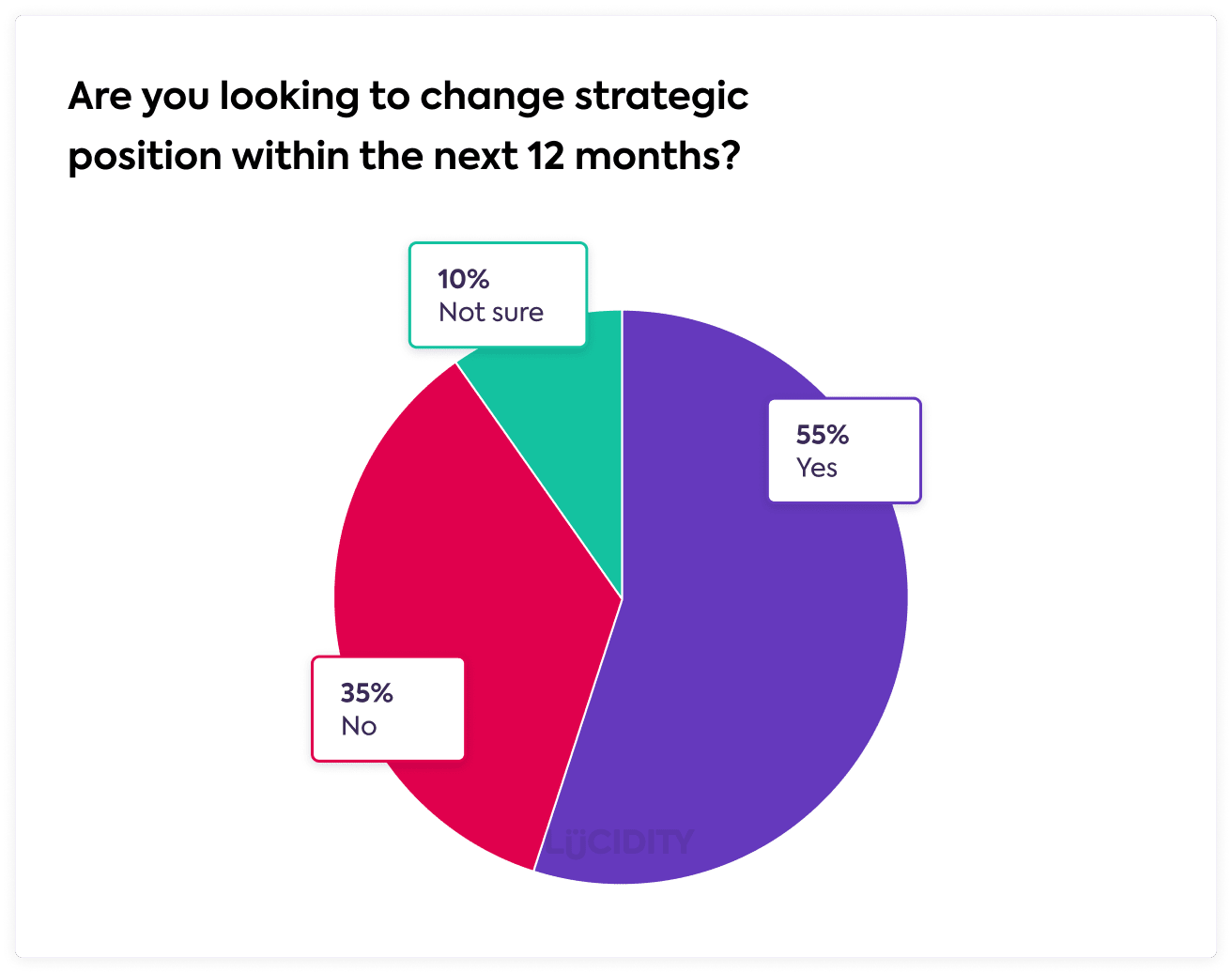There are a number of different strategies you can take to hit your objectives as a company. Different strategies will be better suited to different businesses, different markets and circumstances. However, to ensure you’re making informed and intelligent strategic decisions, it’s important to know all your options and weigh up your strategy against the alternatives.
It’s also useful to know which strategies are more commonly adopted and which are rarer. With that in mind, we surveyed 250 small to medium sized businesses to find out what strategic position they have opted for and why.
We framed our survey around the strategies mapped out in Bowman’s Strategy Clock. The Strategy Clock is a strategic framework that outlines the possible approaches to a market when it comes to growth.
The different possible strategic positions mapped out on Bowman’s Strategy Clock are:
- Low Price & Low Value. This focuses on quantity selling of low value products at a low price
- Low Price. This focuses on being the lowest price offering in the marketplace
- Hybrid. Where buyers have a perception of a low price for a valuable product
- Differentiation. Here you have a high-value product which is different to others
- Focused differentiation. Here you provide high-value at a high price
- Risky high margins, where you have a high price without any added value
- Monopoly, where you’re a single company controlling product and pricing
- And Loss of Market Share, where you are likely in decline or exiting a market
So where do you sit in that list, or are you somewhere in the middle of two? Take a look at our Guide to Bowman’s Strategy Clock for a description of each strategy and see which best matches your situation. Here’s what our survey respondents said when we asked where they position themselves…
So, as you can see, our 250 business leaders cited their market position as…
- Differentiation 55%
- Focused Differentiation 5%
- Risky High Margins 3%
- Monopoly Pricing 0%
- Loss of Market Share 3%
- Low Price & Low Value Added 0%
- Low Price 8%
- Hybrid 26%
Interestingly over 50% of companies state their position is Differentiation. This is a huge majority. Differentiation as a strategic position is all about differentiating your product or service from your competitors by offering something of much higher perceived value. There is a spectrum of course, from your complete product being something very different, to just certain features and aspects of your product or service. The Differentiation strategy relies on strong innovation to drive that value, and successful marketing to create awareness of those features and ensure that perception of high value is achieved.
When a company claims they are positioning themselves as Differentiation you have to consider where they truly are. Are they winning out over their competitors because of the perception of a superior product alone? Or is price also a factor when they win business? Everyone likes to think their product or service is far better than competitors, but it’s worth remembering that that is not the only fruitful strategic position a business can take.
The next most popular strategic position, with 26% of the results, was Hybrid. Here business leaders are claiming their product or service is differentiated from their competitors because of a perceived high-value, but that they have coupled that with a price that customers perceive as low. This strategy sits between the Low Price strategy and Differentiation.
None of the businesses taking part in our research claimed to be adopting the Low Price & Low Value strategy. That isn’t particularly surprising since that is the least competitive position on the Strategy Clock.
Low Price & Low Value Added is a strategy often associated with low margins, and for that reason, it’s not a position many companies find attractive. However, there are a number of businesses who have had significant success adopting this strategic position, so it shouldn’t necessarily be seen negatively. There are a number of successful ‘bargin basement’ type stores that sell low-value, throw-away items for rock-bottom prices and drive growth.
And what of the future…?
It’s fair to say 2020 was an interesting year with plenty of challenges. So it’ll come as no surprise that a lot of businesses have needed to revisit and review their strategies. So how many of the businesses involved in our research are considering moving their position on the Strategy Clock?
So, over the course of the next year, our business leaders said the following about their plans to change to a different strategic position:
Yes 55%
No 35%
Not sure 10%
Strategic positions should always be reviewed and examined to ensure you stay ahead of externals factors impacting your business and market trends, but that is a pretty unique set of respondents that demonstrates just how impacted business has been by the circumstances of 2020.
If you’re in the same position and need to shift your business strategy to ensure you survive and are able to find growth, we recommend watching our webinar on How to Build a Diversification Strategy with lots of advice and guidance on how to do it right.














